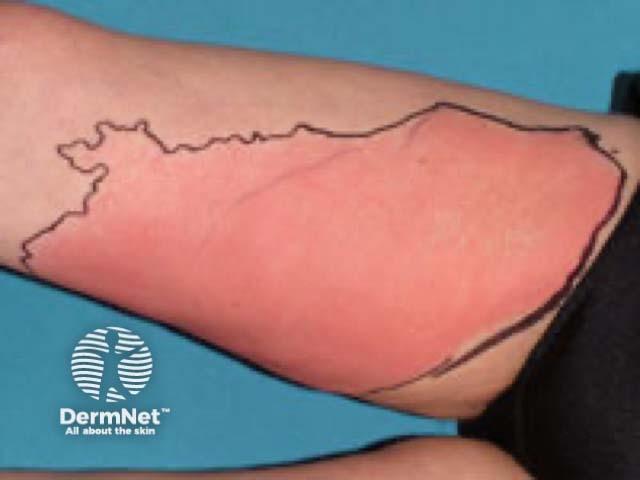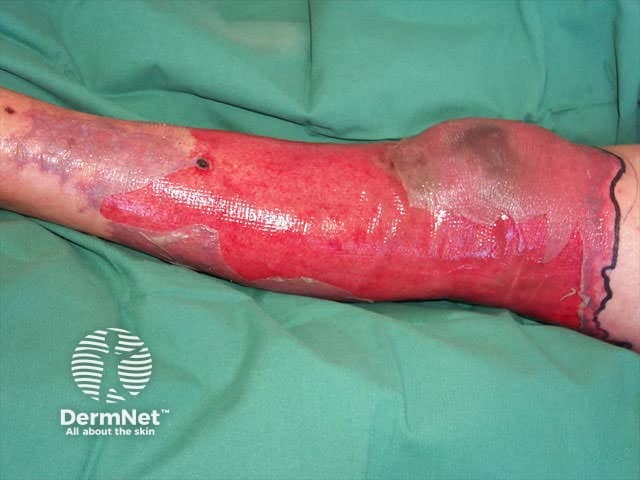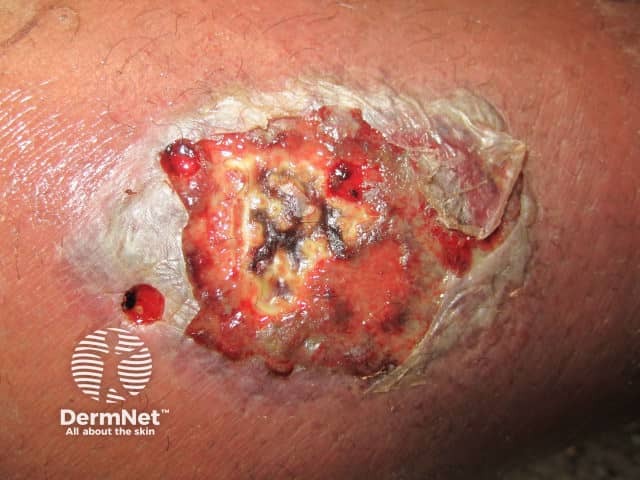Main menu
Common skin conditions

NEWS
Join DermNet PRO
Read more
Quick links
Author(s): Dr Jacob Al-Dabbagh, Faculty of Medicine, Tishreen University, Syria; and Dr Lama Maaita, Department of Dermatology and Venereology, Damascus University, Syria (2023)
Previous contributors: Dr Amy Stanway, Dermatology Registrar, Hamilton (2002)
Reviewing dermatologist: Dr Ian Coulson
Edited by the DermNet content department
Introduction
Demographics
Causes
Clinical features
Variation in skin types
Complications
Diagnosis
Differential diagnoses
Treatment
Prevention
Outcome
Skin and soft tissue infections are a common complication of injecting recreational drugs. Cutaneous abscesses and cellulitis are common presentations in people who inject drugs (PWID), while necrotising fasciitis is a medical emergency.

Cellulitis of the leg after skin popping

Necrotising fasciitis of the leg after a lower leg infection after injecting heroin

A necrotising streptococcal infection after subcutaneous injection of a recreational drug
The practice of injecting subdermally, subcutaneously (‘skin popping’), or intramuscularly (‘muscle popping’) when veins are inaccessible is an important risk factor for developing skin infections. Women are at an increased risk as they may have more difficult venous access. Skin or muscle popping is sometimes done deliberately to cause slower drug absorption and more long-lasting effects.
Other risk factors for skin infections include:
The exact mechanism of infection is related to tissue trauma, ischaemia, and bacterial inoculation. Repeated injections at a single site damage the skin and surrounding tissue, making them more susceptible to infection. The drugs and diluents can increase tissue damage by potentially causing ischaemia, necrosis, vasospasm, and thrombosis.
Infectious pathogens may originate from the skin surface, contaminated needles, or saliva if the injection needle is licked before the injection is administered.
The most common pathogens for bacterial infections include:
Uncommon pathogens include:
Skin infections present classically with swelling, erythema, warmth, and tenderness. Appearances in intravenous drug users can be atypical, because the skin, venous, and lymphatic systems are damaged by frequent trauma and consequent low-grade infection. This may result in lymphoedema, lymphadenopathy, hyperpigmentation, and scarring.
Signs of severe infection include:
Infections usually affect the arms or legs as these are the sites used most frequently for injection, particularly the antecubital fossa of the non-dominant arm. Unusual sites may be involved (eg, abdomen, back, groin, scrotum, legs, and neck) due to injections in the jugular (neck) or femoral (groin) veins.
Types of infections that may be present include:
Much rarer infectious complications of intravenous drug use that have characteristic skin findings include:
Erythema may be less evident in darker skin types, and the affected skin may appear more dusky or violaceous.
Diagnosis is usually made clinically, although laboratory tests and imaging can be useful to confirm the diagnosis and clarify specific aetiologies.
Distinguishing between necrotising and non-necrotising infections can be challenging, and deeper abscesses can sometimes masquerade as cellulitis. Ultrasound, CT, or MRI scans can be helpful in assessing cases further for deep tissue involvement, and potentially guiding therapeutic aspiration. X-rays can help identify underlying osteomyelitis.
Consider sending samples (eg, swabs or aspirates) for microscopy, cultures, and sensitivities; and blood cultures if febrile and there is concern of septicaemia. Inflammatory markers such as white cell count, neutrophil count, and C-reactive protein may be elevated. See also: Laboratory tests for bacterial infections.
Potential differential diagnoses are broad and, depending on clinical presentation, may include:
See also: Cellulitis mimics
Treatment of skin and soft tissue infections usually involves empiric antibiotic therapy (consider adjusting if culture and sensitivities are available), +/- an appropriate therapeutic procedure (eg, incision and drainage of an abscess, or surgical debridement).
Education around harm reduction — measures and advice to reduce infections include:
Both bloodborne viral infections and skin and soft tissue infections increase morbidity and mortality in people who inject drugs. Education about safe injection practices is important. Early diagnosis and appropriate medical care and treatment of infections can help to alleviate symptoms and improve outcomes.